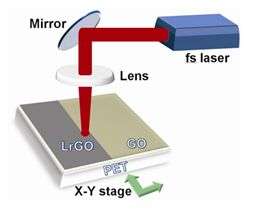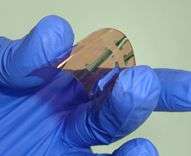Researchers from Greece have demonstrated a groundbreaking methodology for controlled in-situ reduction of spin-casted graphene oxide (GO) nanometric films on flexible substrates and the subsequent realization of highly conductive and transparent electrodes for flexible organic photovoltaics (OPV).
This technique is the first reported to be compatible with temperature sensitive substrates in the sense that it achieves reduction of films on flexible substrates in a single step, in contrast to the approaches utilized so far. Furthermore the featured work provides a new insight in the relevant scientific community considering that it is experimentally clarified that efficient photoreduction of GO can be achieved by exploiting non-thermal processes occurring upon ultrafast laser treatment.
This suggests that there is no need for high temperature treatments that potentially destroy the integrity of the graphene lattice as well as the flexibility of the underlying substrate. The in-situ non-thermal photoreduction of spin-coated GO films creates a novel way to produce functional graphene electrodes for a variety of applications in a process that carries substantial promise for potential implementation in organic electronics industry. By employing the optical schemes and translation systems that have already been developed for industrial lasers, rapid large area processing can be realized that makes this technique easily adaptable to a roll-to-roll manufacturing line for the mass production of OPVs.
Research activities in OPVs in Greece are implemented through a joint effort between the Nanomaterials and Organic Electronics group of the Technical Institute (TEI) of Crete, headed by Prof. Emmanuel Kymakis and the Ultrafast Laser Micro- and Nano- processing group of the Institute of Electronic Structure and Laser (IESL) of the foundation for Research and Technology Hellas (FORTH), headed by Dr. Emmanuel Stratakis, aiming to provide state of the art knowledge in the multidisciplinary field of nanotechnology and advanced electronics. This successful story demonstrates the interplay between the world-leading expertise of IESL-FORTH in optics and laser materials processing with the long-lasting experience of TEI of Crete in carbon nanostructure-based OPVs, initiated after the realization of the first carbon nanotube-based OPV by Kymakis and Amaratunga in 2002.
More information: Publication: Flexible organic photovoltaic cells with in-situ non-thermal photoreduction of spin coated graphene oxide electrodes. Advanced Functional Materials. dx.doi.org/10.1002/adfm.201202713
Journal information: Advanced Functional Materials
Provided by Technological Educational Institute of Crete

























